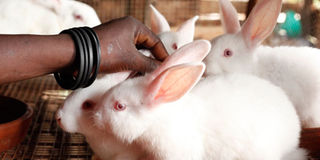Group finds ready market for rabbits

What you need to know:
- The floor of the rabbit hutch should be made of mesh reinforced with a wire mesh to allow dropping to pass through, keeping the rabbits in a clean and dry environment.
By EDGAR R. BATTE
At one end of the agricultural partnership is Dundu Parish Multipurpose Cooperative Society that rears rabbits in Kyampisi in Ziroobwe, Luwero District at another is Jackson Mugisha who runs a rabbit meat processing enterprise that buys and adds value to the rabbits.
In between, is the Microfinance Support Centre (MSC) which links and supports the two. “Our journey started in September last year, with a training at the Benedict Mixed Farm in Ziroobwe. Thomas Ssemakula, a consultant agronomist approached us through the district agricultural officer. He talked to us about the proposal to rear rabbits.
We liked the idea and embraced it,” says Sarah Nakizza, the chairperson of the cooperative that morphed from Tukolere Wammu Women’s Group. The group was drawn in after realising how viable rabbit farming is. Ssemakula had land but no start-up capital. He provided land on which Benedict Mixed Farm sits as a demonstration farm on which farmers such as Tukolere Wammu are learning. The farm has a total of 1,295 rabbits of California white, New Zealand white and black, chinchilla- black, brown and grey types.
Benefits of rabbit farming
Moses Semugga, a manager at Kabulanaka Farm, says rabbit rearing is manageable and one many youth can look to for quick returns. The support centre also provides a push to the learners. It gave 11 rabbits to the women’s group and fostered their agricultural enterprise with Ssemakula, who occasionally checks on them to see to it that they get the necessary husbandry advice.
“We linked them with market for the rabbit meat,” Semakula explains. On return from the training, Nakizza explains that they built rabbit cages, the way they had been trained to.
“Out of the 11, one of the rabbits is male, which services the females. When we realise one of them is on heat, we pair it with the male. After 14 days, you can feel its belly and know it has kittens inside. We also engaged carpenters to make boxes for us. It is in the boxes that the rabbits give birth. We put cotton wool in that box so that the babies get a soft place to stay,” Nakizza explains.
Shelter
The cages are built with timber and iron mesh. “It cost us Shs1.2m. With the rabbits multiplying as they give birth, we are planning to build an extension structure which will cost us Shs700,000,” says Nakizza. The cooperative is composed of a group of nine members who pool resources.
Each of them contributes Shs5,000 per week towards an emergency fund from which they withdraw in case the rabbits fall sick or if there is need to buy supplementary feeds for the rabbits’ diet.
Members harvest and take vegetable feeds for the daily consumption of the rabbits. Otherwise, if none of the eventualities happens, the money is saved.
Record keeping
Nakizza says for transparency, accountability and continuity, they are keen on keeping records. They clean the cages every day, deworm every month.
Their plan is to sell the rabbit meat to Benedict Mixed Farm. Mugisha buys a kilogramme of meat from the farmers at Shs15,000. He adds value to the meat to make minced packages as well as sausages. His enterprise is incubated at the Uganda Industrial Research Institute. His dream is to expand and start his own processing factory.
“On average, we do 1,000 kilogrammes of rabbit sausages a month. I sell to the supermarkets at Shs23,500 per kilogramme of sausages.” Apart from meat, Mugisha makes organic foliar fertiliser from rabbit urine. He sells each litre at Shs20,000. His vision is to do rabbit rearing on a modern scale, with automated cages.




